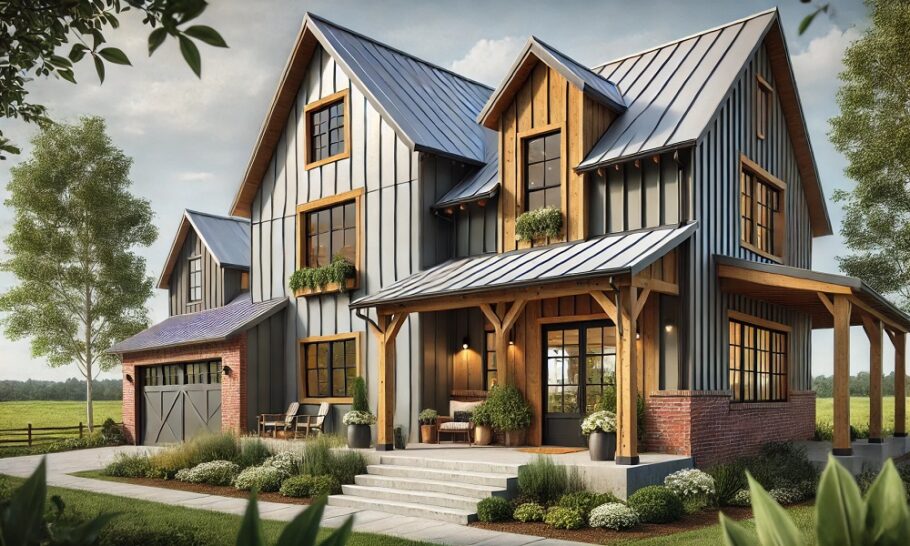When building a barndominium, the exterior is one of the most important aspects to consider. It’s not just about aesthetics—the materials you choose impact the durability, maintenance requirements, and overall value of your home. From metal siding to wood and brick accents, the right combination can elevate your barndominium’s curb appeal while providing long-term protection. In this guide, we’ll explore the best exterior materials for barndominiums and the engineering benefits of each option.
1. Metal Siding
Overview: Metal siding is the quintessential choice for barndominiums, offering a sleek and industrial look. Typically made of steel or aluminum, metal siding is known for its durability and low maintenance.
Advantages:
- Durability: Resistant to rot, pests, and fire, metal siding is an excellent long-term investment.
- Weather Resistance: It stands up to harsh weather conditions, including high winds, rain, and snow.
- Low Maintenance: Requires minimal upkeep; occasional cleaning with a hose or pressure washer keeps it looking new.
- Energy Efficiency: Reflective coatings can help reduce heat absorption, lowering energy costs.
Disadvantages:
- Aesthetic Limitations: Metal siding can feel too industrial for some homeowners, though it can be paired with other materials for a warmer look.
- Noise: In heavy rain or hail, metal siding can amplify noise unless properly insulated.
Cost: Metal siding costs approximately $4-$7 per square foot, depending on the type of metal and finish.
2. Wood Siding and Accents
Overview: Wood brings a warm, rustic charm to barndominiums. It can be used as the primary material or as an accent alongside metal or brick.
Advantages:
- Natural Aesthetic: Creates a cozy, farmhouse-inspired look.
- Customizable: Available in various styles, such as shiplap, board-and-batten, or cedar planks, and can be stained or painted in different colors.
- Sustainability: Sourced from renewable resources, wood is an eco-friendly option when harvested responsibly.
Disadvantages:
- Maintenance: Requires regular staining, sealing, or painting to protect against moisture, pests, and UV damage.
- Durability: More susceptible to rot, warping, and termite damage compared to metal or brick.
- Cost: High-quality wood siding can be expensive, and ongoing maintenance adds to long-term costs.
Cost: Wood siding typically ranges from $6-$12 per square foot, depending on the type of wood.
3. Brick and Masonry
Overview: Brick and stone add a timeless, elegant touch to barndominiums. While often used as accents rather than the primary material, these options offer excellent durability and aesthetic appeal.
Advantages:
- Durability: Extremely long-lasting and resistant to weather, fire, and pests.
- Low Maintenance: Requires little upkeep aside from occasional cleaning.
- Insulation: Brick and stone provide natural insulation, helping regulate indoor temperatures.
Disadvantages:
- Cost: One of the more expensive exterior materials.
- Installation: Requires skilled labor, which adds to the overall cost.
- Weight: Heavier than other materials, which may necessitate additional structural support.
Cost: Brick siding costs $10-$20 per square foot, while natural stone can range from $15-$30 per square foot.
4. Vinyl Siding
Overview: Vinyl siding is a cost-effective and versatile option, often used as a lightweight alternative to wood or metal.
Advantages:
- Affordability: One of the most budget-friendly exterior materials.
- Low Maintenance: Resistant to moisture and pests, vinyl siding only requires occasional cleaning.
- Versatility: Available in a wide variety of colors, styles, and textures, including wood-look options.
Disadvantages:
- Durability: Less durable than metal or brick, prone to cracking or warping in extreme temperatures.
- Environmental Impact: Vinyl is made from PVC, which is not biodegradable.
- Appearance: While improved over the years, vinyl siding may not offer the premium look of wood or brick.
Cost: Vinyl siding costs $2-$6 per square foot.
5. Fiber Cement Siding
Overview: Fiber cement is a composite material made of cement, sand, and cellulose fibers. It’s an excellent middle ground between durability, cost, and aesthetics.
Advantages:
- Durability: Resistant to rot, pests, and fire.
- Low Maintenance: Requires less upkeep than wood but offers a similar appearance.
- Versatility: Can mimic the look of wood, stone, or stucco, and is available in various colors and finishes.
Disadvantages:
- Weight: Heavier than vinyl or wood, requiring sturdy structural support.
- Cost: More expensive than vinyl but less costly than brick or natural stone.
- Installation: Requires professional installation.
Cost: Fiber cement siding costs $5-$10 per square foot.
Engineering Considerations for Barndominium Exteriors
When choosing materials for your barndominium’s exterior, it’s essential to consider the following engineering factors:
- Structural Support: Heavier materials like brick or stone may require reinforced framing to handle the weight.
- Climate Suitability: Metal siding works well in areas with extreme weather, while wood may struggle in humid or wet climates.
- Insulation: Ensure your chosen material contributes to the energy efficiency of your barndominium. Adding insulation behind metal or vinyl siding can improve thermal performance.
- Moisture Management: Proper drainage and weatherproofing are crucial to prevent water damage, particularly with wood and fiber cement siding.
Combining Materials for a Unique Look
Mixing and matching exterior materials can create a distinctive and balanced design for your barndominium. Some popular combinations include:
- Metal Siding with Wood Accents: Combine the durability of metal with the warmth of wood for a modern farmhouse look.
- Brick or Stone Base with Metal or Vinyl Upper: Use brick or stone for the lower portion of the exterior to add visual weight and durability, paired with a lighter material above.
- Fiber Cement with Natural Wood: Pair fiber cement’s low-maintenance durability with wood’s rustic charm for a cohesive design.
Conclusion
The right exterior materials for your barndominium depend on your priorities, budget, and aesthetic vision. Whether you prefer the industrial durability of metal, the timeless elegance of brick, or the natural warmth of wood, there are options to suit every style and need. By considering factors like climate, maintenance, and engineering requirements, you can create a barndominium exterior that’s both stylish and built to last.

